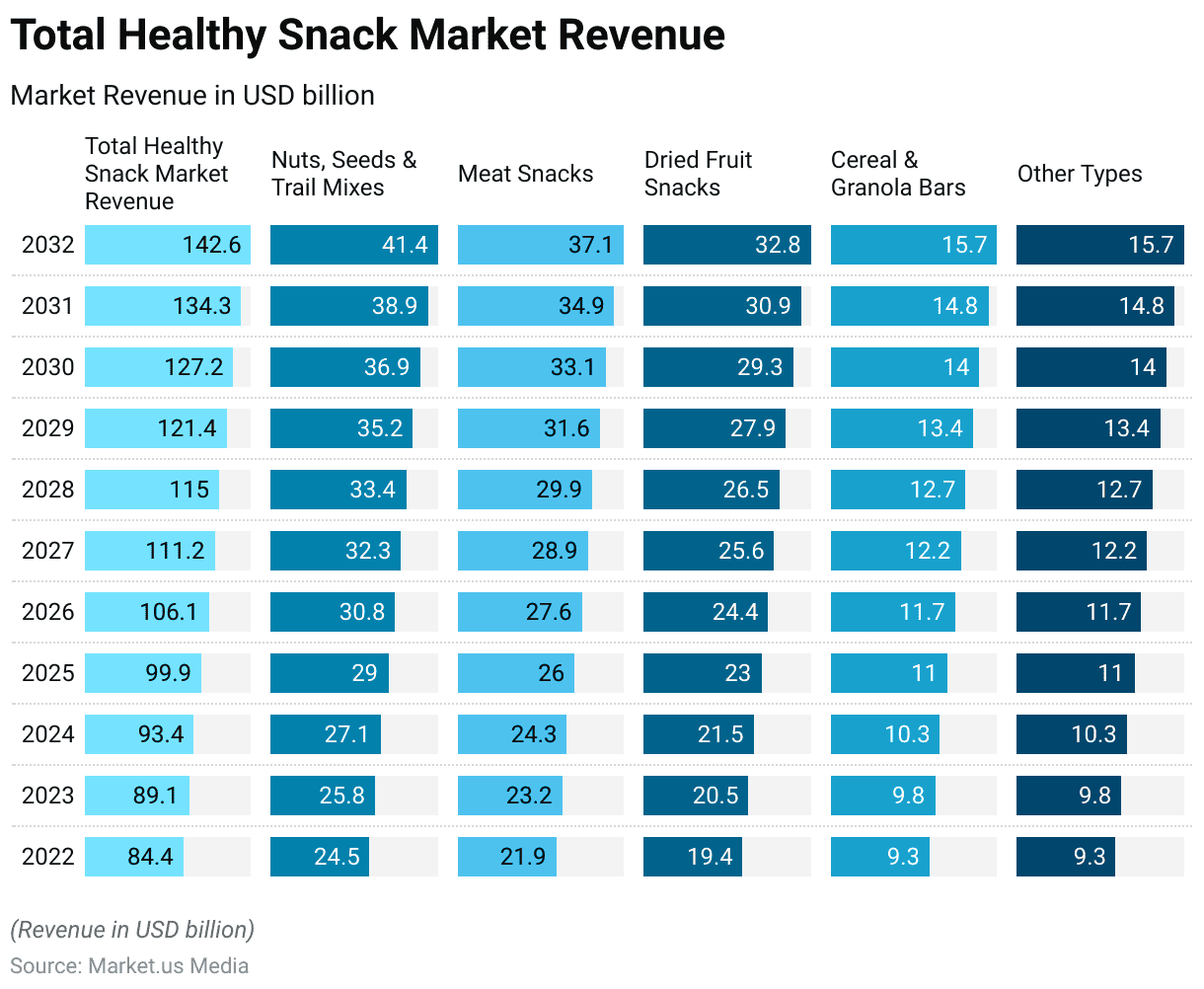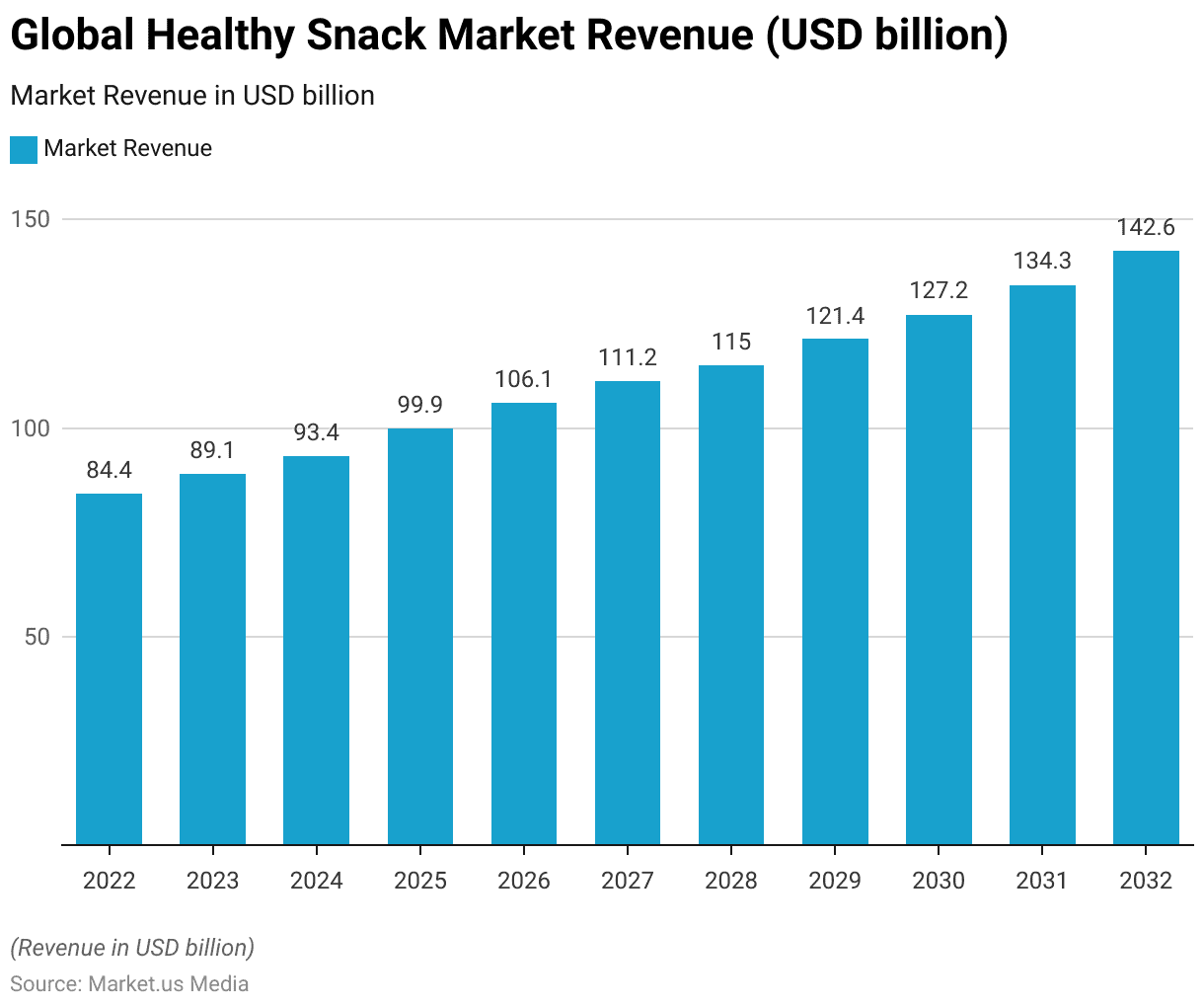Table of Contents
Introduction
According to Healthy Snack Statistics, Healthy snacks play a vital role in a balanced diet, supplying nourishment and vitality between meals while focusing on essential vitamins, minerals, and reduced calorie levels.
They are portioned sensibly to satisfy hunger without excess and offer a well-balanced combination of carbs, proteins, and healthy fats for continuous energy.
These snacks limit added sugars, favoring natural sweetness from fruits or limited sweeteners. They prioritize whole, less-processed ingredients and can also contribute to hydration.
Common choices encompass fresh fruit, vegetables with hummus, Greek yogurt with berries, and nuts, and whole-grain crackers paired with avocado. Opting for snacks aligned with these principles enhances overall health and wellness.
Editor’s Choice
- In 2023, the total healthy snack market revenue reached 89.1 billion USD.
- By 2032, Nuts, Seeds & Trail Mixes are projected to reach 41.4 billion USD in revenue, followed by Meat Snacks at 37.1 billion USD, Dried Fruit Snacks at 32.8 billion USD, Cereal & Granola Bars at 15.7 billion USD, and Other Types at 15.7 billion USD in the same year.
- Among distribution channels, Hypermarkets/Supermarkets hold the largest market share, commanding 31% of the distribution landscape.
- Concerning healthy snacks, in 2021, 91% of surveyed consumers emphasized convenience as their top priority, an increase from 87% in 2020.
- Gen Z consumers are more likely to snack to alleviate anxiety and boredom, while millennials focus on meeting nutritional needs, and Gen X seeks comfort in snacks.
- 72% of consumers are seeking portion-controlled snacks, up from 63% in the previous year
- The COVID-19 pandemic has reshaped consumer snacking habits and shopping behaviors. An overwhelming 80% of consumers expect to have access to their desired snacks at any time, while 74% desire the flexibility to use any shopping channel.

Global Healthy Snack Market Overview
Global Healthy Snack Market Size
- The global healthy snack market is on a consistent growth trajectory at a CAGR of 5.5%, as indicated by its revenue in USD billion over the next decade.
- In 2022, it stood at 84.4 billion, and this upward trend is projected to continue.
- By 2023, the market is expected to reach 89.1 billion, followed by 93.4 billion in 2024.
- Looking ahead, the market is projected to grow further, with expected revenues of 134.3 billion in 2031 and 142.6 billion in 2032.

Healthy Snack Market Size – By Type
- The global healthy snack market, segmented by type, demonstrates a substantial growth trajectory over the next decade.
- In 2022, the total healthy snack market revenue reached 84.4 billion USD.
- Among the specific categories, Nuts, Seeds & Trail Mixes accounted for 24.5 billion USD, followed by Meat Snacks at 21.9 billion USD, Dried Fruit Snacks at 19.4 billion USD, Cereal & Granola Bars at 9.3 billion USD, and Other Types also at 9.3 billion USD.
- This upward trend is projected to continue, with total market revenue expected to increase to 142.6 billion USD in 2032.
- Notably, Nuts, Seeds & Trail Mixes are projected to reach 41.4 billion USD in revenue, followed by Meat Snacks at 37.1 billion USD, Dried Fruit Snacks at 32.8 billion USD, Cereal & Granola Bars at 15.7 billion USD, and Other Types at 15.7 billion USD in the same year.

Healthy Snack Market Share – By Distribution Channel
- The global healthy snack market distribution is characterized by a diverse range of channels, each contributing to its widespread availability.
- Among these channels, Hypermarkets/Supermarkets hold the largest market share, commanding 31% of the distribution landscape.
- Following closely behind are Convenience Stores, with a substantial 27% market share, and Specialty Stores with 18%.
- Online Retail has emerged as a significant player, accounting for 14% of the market share, reflecting the growing trend of consumers purchasing healthy snacks through digital platforms.
- Other Distribution Channels collectively contribute 10% to the market, emphasizing the multi-faceted approach taken by the industry to reach consumers through various retail avenues.

Nutritional Requirements
- The standard reference for calorie intake on food labels is set at 2,000 calories, yet the specific daily calorie requirement varies based on factors like age, gender, activity level, and weight goals, be it gaining, maintaining, or losing weight.
- To promote a healthier diet, the 2015 Dietary Guidelines for Americans advise keeping added sugar intake to less than 10% of daily calorie intake.
- Added sugars contribute calories without providing significant nutrients, making it important to choose foods and beverages with minimal added sugars.
- Furthermore, the same guidelines recommend limiting daily sodium intake to below 2,300 milligrams (mg).
Motivating Factors for Eating Healthy Snacks
- According to a 2018 survey in the United States, individuals had various motivations for choosing to consume healthy snacks.
- The primary motivating factor was a concern for general well-being, with 62% of respondents emphasizing the importance of their overall health.
- Feeling good about oneself closely followed, as 58% of participants noted that their self-esteem played a significant role in their choice of healthy snacks.
- Weight management was also a key driver, with 47% indicating a desire to lose weight, and 45% aiming to maintain their current weight.
- Preventing disease and illness was another compelling factor, also at 45%, reflecting the growing awareness of the role of nutrition in health.
- Additional motivations included the desire to boost energy, cited by 37% of respondents, as well as managing existing health conditions, which motivated 24% of those surveyed.
- Interestingly, a smaller percentage, 12%, sought healthy snacks as a means to gain weight.

Demand for Healthy Snacks
- There has been a remarkable surge in demand for various types of healthy snacks, as indicated by the substantial percentage increases in popularity.
- Leading the way is “Kibo” with an astonishing 794.38% increase in demand, underscoring its rapid growth in consumer preference.
- “Veggie Crisps” have also witnessed a significant surge, experiencing a 565.93% increase, followed closely by “Miss Vickies” with a remarkable 406.86% rise in demand.
- “Terra” and “Beet Chips” have both shown substantial increases of 199.01% and 150.62%, respectively, reflecting the growing interest in alternative snack options.
- “Bare,” “Nut Thins,” and “Lentil Chips” have all seen notable surges in demand, with increases of 111.44%, 97.38%, and 93.79%, respectively.
- Lastly, “Late July” and “Brads” round out the list with significant growth percentages of 74.05% and 60.49%, reaffirming the evolving preferences of consumers towards healthier snacking choices across a variety of brands and options.

Healthy Snack Choices
- In 2017, a notable shift towards healthier snack choices was observed among respondents in the United Kingdom (UK).
- Among the various product categories, fruits emerged as the top choice, with 31% of respondents indicating an increase in consumption.
- Vegetables closely followed at 29%, highlighting a growing preference for plant-based snacking.
- Yogurt was another popular healthy snack, with 18% of respondents opting for this dairy product.
- Nut-based snacks and rice cakes also gained traction, with 14% and 13% of respondents, respectively, choosing these options for their healthier snacking habits.

Consumer Preferences for Healthy Snacks
- Concerning healthy snacks, in 2021, 91% of surveyed consumers emphasized convenience as their top priority, an increase from 87% in 2020.
- Freshness closely followed at 90% (up from 85% in 2020), with indulgence at 85% (up from 81%), healthy at 84% (up from 80%), energizing at 82% (up from 79%), and uniqueness at 74% (up from 68%). Furthermore, the concept of snacking has evolved, with 82% stating that snacks have served different purposes in various life phases.
- Gen Z consumers are more likely to snack to alleviate anxiety and boredom, while millennials focus on meeting nutritional needs, and Gen X seeks comfort in snacks.
- Over three-quarters of consumers have altered their snack choices over the past three years, and 84% anticipate a broader range of snack options in the next three years. Additionally, consumers view snacks as enhancers of physical (80%), mental (75%), emotional (80%), and social (65%) well-being in their daily lives.
- The survey revealed an increasing demand for functional snacks, with 78% of consumers now snacking regularly to meet their body’s needs or nutritional requirements, marking an 8% increase from 2020.
- A smaller percentage, 29%, expressed interest in plant-based functional snacks, while 23% mentioned a preference for gluten-free options.
- Despite the focus on health, 79% of consumers still value snacks purely for enjoyment or satisfaction. Flavor remains a priority, as 85% are unwilling to compromise on taste, and 74% cannot envision a world without chocolate.
Regulatory Guidelines for Qualifying as a Healthy Snack
- A minimum of half the drinks offered in vending machines or micro-markets should be categorized as healthy beverages.
- For a beverage to qualify as healthy, it must meet specific criteria. This includes plain or carbonated water of any size, unflavored 1% milk up to 12 fluid ounces, and unflavored.
- Additionally, eligible beverages encompass 100% fruit juice without added sweeteners.
- Low-calorie options are permissible, with a maximum of 60 calories per container, and calorie-free choices are allowed with no more than 10 calories per container. These standards collectively define what constitutes a healthy beverage.
- Additionally, all snacks should contain no artificial trans-fat.
- Refrigerated vending machines and micro-markets should have a minimum of four snacks consisting of fruits without added sugar, fat, or salt. However, fruits with added fat, sugar, or salt are acceptable if these additives are separately packaged.
Discuss your needs with our analyst
Please share your requirements with more details so our analyst can check if they can solve your problem(s)



